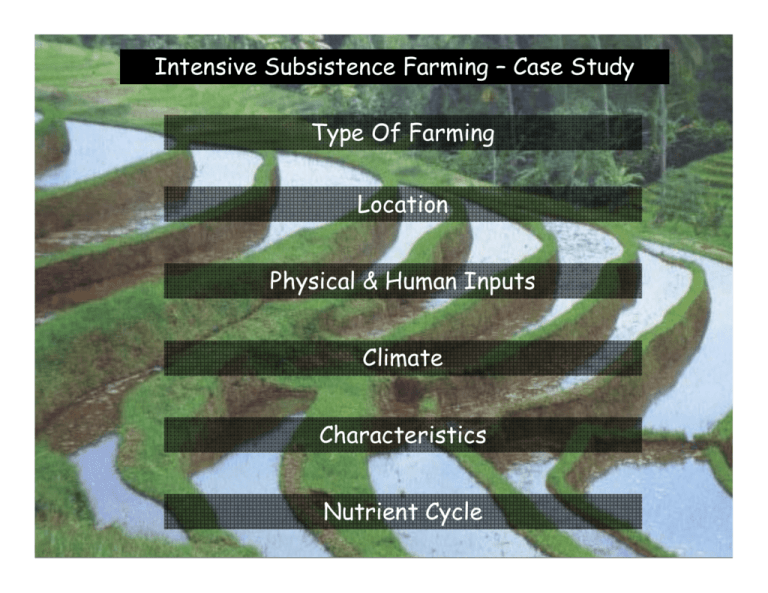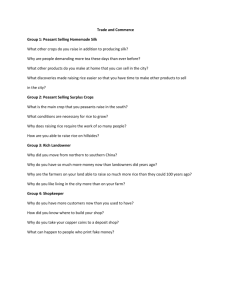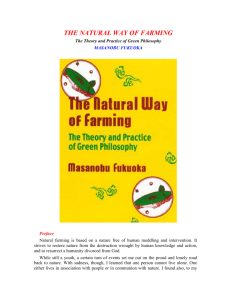Intensive Subsistence Farming – Case Study
advertisement

Intensive Subsistence Farming – Case Study Type Of Farming Location Physical & Human Inputs Climate Characteristics Nutrient Cycle What is it and where is it? What Intensive means the maximum yield is obtained from the land Lots of labour, but a small area Where S.E Asian Monsoon Lands China, Malaysia & India “The Ins” Of Intensive Subsistence Farming Physical Hot temperatures Heavy Monsoon Rain Sunny To Ripen Rice Fertile Alluvial Soil Flooding Rivers Flat Land Sunny Autumns Human Nurseries Water Buffalo Plough Transplanting Terraces Seed Simple Tech. & Chems. Labour & Capital Climate Graph Jan – still warm enough for crops Oct – rice harvested 350 X 30 Temp °C X X X 25 20 X X X 300 X X 250 X X X 200 15 Rain 150 mm 10 100 5 50 0 0 J F M A Jun – Monsoon rains & rice harvested M J J Months A S O N D Nov – second crop planted Characteristics The farmer has to make sure that the earth banks (bunds), which surround the fields are capable of holding water. The walls trap the rainwater. They also reduce sol erosion by holding in the soil. The rice seeds are grown first in nursery beds. The seedlings are transplanted at a few weeks into the padi fields when they are about 15cm high. This is very time consuming, but they need to be the correct distance apart to gain maximum yield. Characteristics The water has be kept at the correct level to ensure the upper parts of they plant are nor submerged. Water is fed in from the feeder canals and transferred from nearby fields by making a gap in the bund. The padis are constantly weeded. Characteristics When the stalks are dry they are threshed or hit against a hard surface making the seeds drop out. They are then taken to a factory for the outer shell to be removed and packaged ready for sale. Once the rice matures, the farmers drain the fields and wait for the rice to ripen. Harvesting is done by hand using a knife or sickle and the stalks laid out to dry. The farmer makes sure the earth banks surrounding the fields can hold the water. They trap rainwater and reduce soil erosion by holding the soil. Rice is grown in nurseries and then transplanted into padi fields at about 15cm high. This is time consuming, but they need to be correctly spaced to gain maximum yield. Water is monitored so rice is not submerged, it is fed by canals & transferred from nearby fields by making a gap in the bund. The padis are constantly weeded. Once the rice matures farmers drain the fields for it to ripen. Harvesting is done using a sickle & the stalks laid out to dry. The dry stalks are threshed or hit against a hard surface, removing the seeds. They are taken to a factory where the outer shell is removed and seeds then sold. Terraces on steep land creates more land to farm Water buffalo power basic technology & provide manure As you found from a previous homework you are expected to be able to label or annotate diagrams correctly. Use the characteristics below to label your sketches of an Intensive Subsistence Farming Area. Soil Bunds ~ Flooded fields ~ Simple technology ~ Transplanting Rice ~ Labour Intensive ~ Terracing ~ Rice Crop ~ Water Buffalo Soil Bunds Flooded Fields Water Buffalo Simple Technology Labour Intensive Terracing Rice Crop Transplanting Rice Nutrient Cycle Dead plants Human waste add nutrients Weathered rock releases nutrients Nitrogen added by algae Nutrient uptake by rice crop Little leaching due to puddled surface The Green Revolution Remember the three questions? What? Why? Where? When? What was the Green Revolution The green revolution saw a major change in farming methods in many parts of the developing world. It began in Mexico and was financed by the United States. The Green Revolution began with the development of High Yielding Variety Cereals. These new strains of crops produced more yields and where also more resistant to disease. These new strains of crops where also used in India at the start of the 1960’s and virtually saved the country from famine. The new starin of rice used in the fields produced ten times as much as rice Which was previously used.







